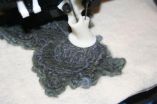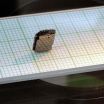(Press-News.org) Research at the University of Illinois has demonstrated that smartphone sensors — not just the ones meant to track your location — can leave real-time fingerprints unique to each individual device. An attacker could use such sensor data from a given smartphone to identify it ever after, almost making the user-trackable.
Research by Electrical and Computer Engineering Associate Professor Romit Roy Choudhury and graduate students Sanorita Dey and Nirupam Roy, demonstrated that these fingerprints exist within smartphone sensors, mainly because of imperfections during the hardware manufacturing process.
In some ways, it's like cutting out sugar cookies. Even using the same dinosaur-shaped cutter, each cookie will come out slightly different: a blemish here, a pock there. For smartphone sensors, these imperfections simply occur at the micro- or nanoscale.
Their findings were published at the Network and Distributed System Security Symposium (NDSS). The research also won the best poster award at the HotMobile international workshop in 2013.
The researchers focused specifically on the accelerometer, a sensor that tracks three-dimensional movements of the phone — essential for countless applications, including pedometers, sleep monitoring, mobile gaming — but their findings suggest that other sensors could leave equally unique fingerprints.
"When you manufacture the hardware, the factory cannot produce the identical thing in millions," Roy said. "So these imperfections create fingerprints."
Of course, these fingerprints are only visible when accelerometer data signals are analyzed in detail. Most applications do not require this level of analysis, yet the data shared with all applications — your favorite game, your pedometer — bear the mark. Should someone want to perform this analysis, they could do so.
The researchers tested more than 100 devices over the course of nine months: 80 standalone accelerometer chips used in popular smartphones, 25 Android phones and two tablets.
The accelerometers in all permutations were selected from different manufacturers, to ensure that the fingerprints weren't simply defects resulting from a particular production line.
With 96-percent accuracy, the researchers could discriminate one sensor from another.
"We do not need to know any other information about the phone — no phone number or SIM card number," Dey said. "Just by looking at the data, we can tell you which device it's coming from. It's almost like another identifier."
In the real world, this suggests that even when a smartphone application doesn't have access to location information (by asking "this application would like to use your current location"), there are other means of identifying the user's activities. It could be obtained with an innocuous-seeming game or chatting service, simply by recording and sending accelerometer data. There are no regulations mandating consent.
To collect the data, the researchers — as with any would-be attacker — needed to sample the accelerometer data. Each accelerometer was vibrated using a single vibrator motor — like those
that buzz when a text message is received — for two-second intervals. During those periods, the
accelerometer detected the movement and the readings were transmitted to a supervised learning tool, which decoded the fingerprint.
"Even if you erase the app in the phone, or even erase and reinstall all software," Roy said, "the fingerprint still stays inherent. That's a serious threat."
At this point, however, there is no absolute solution. Smartphone cases made of rubber or plastic do little to mask the signal. Deliberately injecting white noise in the sensor data can
smudge the fingerprint, but such noise can also affect the operation of the application, making your pedometer inaccurate and functionally useless.
The research also suggests that other sensors in the phone — gyroscopes, magnetometers, microphones, cameras, and so forth — could possess the same types of idiosyncratic differences. So even if, at a large scale, the accuracy of accelerometer fingerprints diminishes, when combined with prints from other sensors, an attack could be even more precise.
"Imagine that your right hand fingerprint, by some chance, matches with mine," Roy Choudhury said. "But your left-hand fingerprint also matching with mine is extremely unlikely. So even if accelerometers don't have unique fingerprints across millions of devices, we believe that by combining with other sensors such as the gyroscope, it might still be possible to track a particular device over time and space."
For smartphone users and e-book readers, smartwatch wearers and tablet devotees, perhaps the most critical take-home message, in the short run anyway, is the importance of vigilance.
"Don't share your accelerometer data without thinking about how legitimate or how secure that application is," Dey said. "Even if it's using only the sensor data, still it can attack you in some way. The consumer should be aware."
INFORMATION:
Other collaborators on this project are Srihari Nelakuditi and Wenyuan Xu at the
University of South Carolina, where Nirupam and Sanorita completed their master's degrees.
Research shows smartphone sensors leave trackable fingerprints
2014-04-28
ELSE PRESS RELEASES FROM THIS DATE:
Carnegie Mellon-Disney researcher invents 3D printing technique for making cuddly stuff
2014-04-28
PITTSBURGH—Soft and cuddly aren't words used to describe the plastic or metal things typically produced by today's 3D printers. But a new type of printer developed by Carnegie Mellon University and Disney Research Pittsburgh can turn wool and wool blend yarns into fabric objects that people might actually enjoy touching.
The device looks something like a cross between a 3D printer and a sewing machine and produces 3D objects made of a form of loose felt. Scott Hudson, a professor in CMU's Human-Computer Interaction Institute who developed the felting printer with Disney ...
Beyond graphene: Controlling properties of 2D materials
2014-04-28
The isolation of graphene at the University in 2004 led to the discovery of many other 2D crystals. While graphene has an unrivalled set of superlatives, these crystals cover a large range of properties: from the most conductive to isolating, from transparent to optically active.
The next step is to combine several of these crystals in a 3D stack. This way, one can create 'heterostructures' with novel functionalities – capable of delivering applications as yet beyond the imagination of scientists and commercial partners.
The first examples of such heterostructures already ...
One cell type may quash tumor vaccines
2014-04-28
(PHILADELPHIA) -- Most cancer vaccines have not lived up to their promise in clinical trials. The reason, many researchers suspect, is that the immune cells that would help the body destroy the tumor – even those reactions boosted by cancer vaccines – are actively suppressed. Now, researchers at Thomas Jefferson University have found that a single cell type is actively suppressed in several experimental cancer vaccines, paving the way toward methods to break suppression and improve the effectiveness of cancer vaccines. The work was published this week online in the European ...
Ames Lab researchers see rare-earth-like magnetic properties in iron
2014-04-28
Scientists at the Department of Energy's Ames Laboratory have observed magnetic properties typically associated with those observed in rare-earth elements in iron. These properties are observed in a new iron based compound that does not contain rare earth elements, when the iron atom is positioned between two nitrogen atoms. The discovery opens the possibility of using iron to provide both the magnetism and permanence in high-strength permanent magnets, like those used in direct-drive wind turbines or electric motors in hybrid cars. The results appeared in Nature Communications.
In ...
Estimating baby's size gets more precise
2014-04-28
New Michigan State University research aims to help doctors estimate the size of newborns with a new set of birth weight measurements based on birth records from across the country.
"More than 7 million records were reviewed," said Nicole Talge, an assistant professor in MSU's Department of Epidemiology and Biostatistics, who co-led the study which is now available in the journal Pediatrics.
"Our research looked at live births in the United States during 2009-2010 and using a newly developed method, corrected unlikely gestational ages during that time. This led to changes ...
Gulf War illness: New report lauds treatment research, confirms toxic causes
2014-04-28
Progress has been made toward understanding the physiological mechanisms that underlie Gulf War illness and identifying possible treatments, according to a report released Monday by a Congressionally mandated panel of scientific experts and veterans.
Treatment research has increased significantly since 2008, and "early results provide encouraging signs that the treatment goals identified in the 2010 Institute of Medicine report are achievable," the Research Advisory Committee on Gulf War Veterans' Illnesses (RAC) said in a report presented Monday to VA Secretary Eric ...
Studies offer insight on how to improve kidney and liver transplantation
2014-04-28
The quality of kidney and liver donations is fundamentally important for the longevity of transplants and the health of recipients. That's why it's critical to know which organs are suitable for transplantation, as well as to use techniques that preserve an organ's function after donation. Several studies published in the BJS (British Journal of Surgery) address these issues and offer ways to maximize the use of donated organs.
In the first study, Rajeev Desai, MRCP, of NHS Blood and Transplant, in the UK, led a team that assessed transplants from 17,639 donors, including ...
R.I. nitrogen cycle differs in bay and sound
2014-04-28
PROVIDENCE, R.I. [Brown University] — Rhode Island's geography is famously small, but new measurements of the nitrogen cycle in its waterways suggest that even over a small distance, differences can be huge. Scientists report that the nitrogen-converting process anammox is almost completely absent in Narragansett Bay, even though it is going strong in Rhode Island Sound only 15 miles off the coast.
The novel and somewhat surprising finding, documented in the journal Limnology and Oceanography, raises intriguing questions about why the bay seems inhospitable to an important ...
Breast cancer patients place huge emphasis on gene expression profiling test
2014-04-28
TORONTO, April 28, 2014—Gene expression profiling tests play a critical role when women with early-stage breast cancer decide whether to have chemotherapy, but many of them do not fully understand what some of the test results mean, new research suggests.
Current guidelines for treating early-stage breast cancer—cancer that has not spread to nearby lymph nodes or other parts of the body—result in thousands of women receiving chemotherapy without benefitting from it.
A gene expression profiling test can help differentiate women who might benefit from chemotherapy versus ...
Increasing sugar concentration in tomato juice
2014-04-28
TOKYO, JAPAN – To increase the sugar concentration and resulting marketability of tomato juice, growers have traditionally used techniques such as subjecting plants to salt and water stresses. In a new study published in HortTechnology (February 2014), Ken Takahata and Hiroyuki Miura from Tokyo University of Agriculture reported on a prototypic method known as "basal wire coiling" that shows potential as a simple and effective method for increasing the sugar concentration in tomato fruit juice.
"We investigated whether coiling wire around the lower part of the plant stems ...




